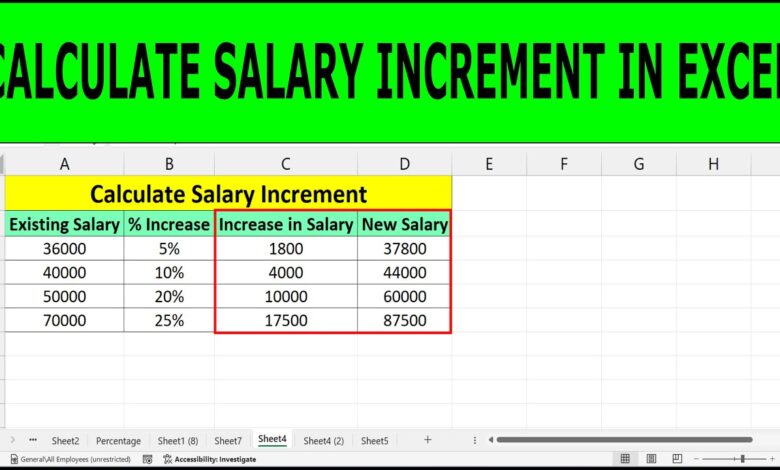Salary Percent Increase Calculator: A Guide to Understanding and Calculating Pay Raises

Calculating salary increases can be a game-changer when planning personal finances or deciding on a job offer. The salary percent increase calculator makes it simple to understand how much your earnings are growing year after year or after receiving a promotion. In this guide, we’ll walk through everything you need to know about calculating salary increases, why they’re essential, and how they can impact your financial future.
What is a Salary Percent Increase Calculator?

A salary percent increase calculator is a tool designed to help you calculate the percentage increase in salary over a given period. It’s particularly useful when employers give raises based on performance, market rates, or as part of a promotion package. By entering your old salary and your new salary, you can easily determine the percentage increase in your earnings.
Why Use a Salary Percent Increase Calculator?
A salary percent increase calculator provides a straightforward way to:
- Understand pay adjustments and see if they’re meeting inflation or industry standards.
- Evaluate job offers by comparing potential salary increases with your current earnings.
- Plan financial goals based on expected salary growth, especially if you aim to save or invest more each year.
- Track career progress by reviewing salary increases over time.
Knowing how to calculate salary increases with accuracy can make a big difference when negotiating your next raise or budgeting for the future.
How to Calculate Salary Percent Increase Manually
While a calculator makes things faster, calculating your salary increase percentage by hand can help understand the math behind it. Here’s a simple formula to use:
Percent Increase=(New Salary−Old SalaryOld Salary)×100\text{Percent Increase} = \left( \frac{\text{New Salary} – \text{Old Salary}}{\text{Old Salary}} \right) \times 100Percent Increase=(Old SalaryNew Salary−Old Salary)×100
Example Calculation
Imagine you received a raise, increasing your annual salary from $50,000 to $55,000. Here’s how you’d calculate the percentage increase:
- Subtract the old salary from the new salary:
- $55,000 – $50,000 = $5,000
- Divide the difference by the old salary:
- $5,000 ÷ $50,000 = 0.1
- Multiply by 100 to get the percentage:
- 0.1 × 100 = 10%
So, your salary increase is 10%.
Benefits of Using a Salary Percent Increase Calculator
Calculating raises can be complex when done manually, especially if you’re looking at different periods or amounts. Using a salary percent increase calculator can save time and minimize errors. Here’s why it’s beneficial:
- Quick Calculations: Inputting numbers into a calculator is quicker than doing the math by hand.
- Accuracy: Calculators reduce human error, giving you confidence in the result.
- Ease of Use: Calculators are user-friendly, often with input fields for your old and new salaries, instantly showing the percentage change.
- Multiple Calculations: Many calculators allow you to store or compare different salary increases over the years.
Types of Salary Increases
Understanding the types of salary increases is essential for accurate calculations. Here are a few common types:
- Merit-Based Increases: Raises given based on job performance, often reviewed annually.
- Cost-of-Living Adjustments (COLA): Increases made to match inflation, ensuring your purchasing power remains consistent.
- Promotional Raises: Salary bumps that come with a job promotion, are often more significant than merit-based increases.
- Market Adjustments: Adjustments made to align with market salary rates for a specific role or industry.
Using a Salary Percent Increase Calculator: Step-by-Step Guide
Using a salary percent increase calculator is typically straightforward. Here’s a general step-by-step guide:
- Find a Reliable Calculator: Many salary percent increase calculators are available online for free.
- Input Your Old Salary: Enter your previous salary before the increase.
- Enter the New Salary: Input the new salary amount post-raise.
- Calculate the Percent Increase: Hit the “Calculate” button to get your result.
- Analyze Your Results: Consider if the raise meets your financial goals or if it’s time to negotiate further.
Table: Sample Salary Increase Calculations
Here’s a quick reference to help you understand the impact of various percentage increases on different salaries.
Old SalaryNew SalaryIncrease (%)
$50,000 $52,500 5%
$50,000 $55,000 10%
$50,000 $57,500 15%
$50,000 $60,000 20%
$50,000 $65,000 30%
Factors to Consider When Evaluating Salary Increases
Not all salary increases are the same. While a higher percentage is often better, other factors also play a role in understanding how beneficial the increase is:
- Inflation Rates: Inflation can reduce the value of your raise if it’s not adjusted to match or exceed the annual inflation rate.
- Job Role and Industry: Certain industries, such as tech or finance, may offer higher annual increases.
- Workload and Responsibilities: A salary increase that comes with significantly more responsibilities should ideally be higher to reflect the extra effort.
Common Mistakes When Calculating Salary Percent Increase
When calculating salary percent increases, it’s easy to make errors if you’re not careful. Here are some common pitfalls:
- Using the Wrong Base Salary: Make sure you’re calculating from your most recent salary, not a starting salary from years ago.
- Ignoring Additional Benefits: Sometimes, salary increases come with added benefits like bonuses, stock options, or healthcare improvements.
- Rounding Errors: Try to avoid rounding up numbers until the final calculation to keep the percentage accurate.
Tips for Negotiating a Better Salary Increase
Knowing your salary percent increase can give you the confidence to negotiate better raises. Here are some tips to boost your negotiation strategy:
- Research Industry Standards: Knowing the average raise percentage in your field can strengthen your case.
- Highlight Your Achievements: Documenting your accomplishments shows your employer the value you bring.
- Focus on Value, Not Just Numbers: Explain how your skills and experience benefit the company and warrant a raise.
- Consider Non-Monetary Perks: Sometimes, companies can offer additional perks instead of a larger raise. If the salary increase is limited, try negotiating for more vacation days or professional development opportunities.
Frequently Asked Questions about Salary Percent Increase Calculators
- Can I use a salary percent increase calculator for bonuses?
Yes, you can calculate the percentage increase of a bonus using the same formula. Simply replace the “old salary” with the old bonus amount and the “new salary” with the new bonus amount to determine the percentage increase.
- What is a good salary increase percentage?
A good salary increase percentage varies by industry but generally falls between 3% and 5% for annual raises. However, for promotions or outstanding performance, increases of 10% or more are common.
- How often should I calculate my salary percent increase?
It’s beneficial to calculate your salary increase annually or whenever you receive a pay adjustment. This helps you stay on top of your financial progress and assess whether your earnings are growing at a satisfactory rate.
- Do salary percent increase calculators account for inflation?
No, most salary percent increase calculators focus solely on the change in salary. To see if your raise covers inflation, compare the raise percentage to the annual inflation rate.
Closing Thoughts on Using a Salary Percent Increase Calculator
Using a salary percent increase calculator is a simple yet powerful way to understand the growth in your earnings. Regularly calculating your salary increase percentage helps you stay informed, negotiate effectively, and set achievable financial goals. Whether you’re planning for a big career leap or just want to ensure your earnings are on track, knowing how to calculate your salary increase is a valuable skill.

